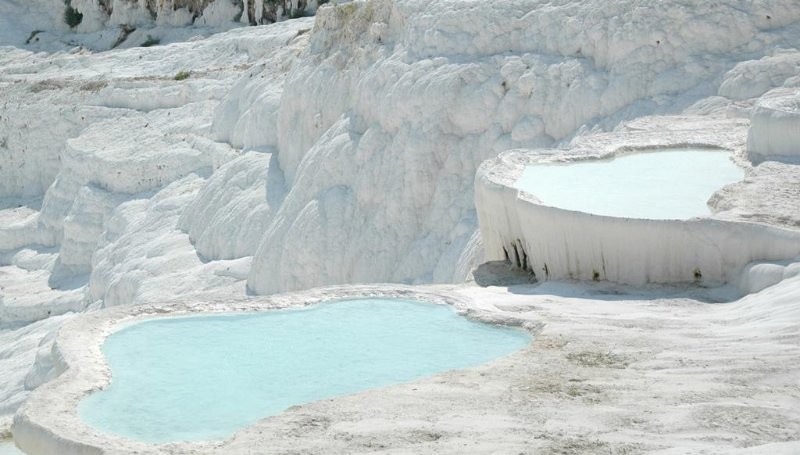Pamukkale AntikHierapolis
Pamukkale (Cotton Castle) is a natural warm water thermal area located in the Aegean region of Turkey. What puts Pamukkale apart from the many thermal water springs in the world and Turkey is that the thermal water in Pamukkale occurs magnificent beauty of travertines in a big area which is unique in the world.
In the past it was a volcanic area and the Mountain Colossae, 2600m high, was one of the highest volcanic mountains in Turkey which is believed to be 14.000 year old. As a result of an earthquake by chance, this blue water at the temperature of 35 degrees came out to the surface and the result of the chemical reaction of the Calcite Carbonate, and the deposition of lime in this incredible cotton-colored calcium deposits, travertines formed. Calcium Carbonate, Magnesium, Sodium, Iron, Carbon Dioxide are present in the water. When carbon dioxide reach the air, Carbon Dioxide disappears and Calcium Carbonate precipitates and forms these shapes. The warm thermal water is beneficial for skin, kidney stones, eyes, physical exhaustion, digestive maladies, circulatory issues, nutritional disorders and chronic disorders. Because of its stunning views and very healthy water, Pamukkale is one of the most popular visited destinations in Turkey. But this was also the case in ancient times. Therefore, the Kingdom of Pergamum established a settlement in Pamukkale 2.300 years ago. Hiera, the wife of the legendary Telephos, the founder of the Kingdom of Pergamum, was named after this city. So the name of the city was Hierapolis. The city of Hierapolis became famous after the arrival of the Romans in the 2nd century BC.
The Romans built the city and made it a thermal city where thermal water was used, building a lot of great Roman baths. So many Roman Emperors visited Anatolia and enjoyed this thermal water. Cleopatra and Marc Antoni were on their honeymoon at Hierapolis.
Today Pamukkale and the ancient city of Hierapolis are located at the famous Menderes Valley and the ancient Lycus River at 140 high. There is a wonderful ancient theater in Hierapolis in great condition, two Roman baths, one of which is currently used as a museum and contains finds from excavations in the ancient city of Hierapolis. There is also an ancient fountain building and a temple built for Apollo, the main god of the city. Next to the temple, there is a sanctuary for Pluto, the son of Apollo, and it is still possible to hear the very poisonous Plutonium gas here. In addition, during the Christian period, Hierapolis became an important archbishop center and there was a large church just behind the big bathhouse. What makes Hierapolis important and sacred in terms of Christianity is the martyr of the Apostle Philip here. Very recently, the tomb of Saint Philip was discovered and excavations started there. In the city there is a very beautiful ancient street dating back to ancient times and there are monumental gates at both ends. These are Domitian and Byzantine gates.
But the most important thing that comes to mind when saying Hierapolis is undoubtedly the Necropolis graveyard. It is the largest open-air ancient tombs in Turkey, more than 1200 graves and 4 different types have been identified. These graves are between 2300 and 1500 years old. There are 4 grave types: tumuli, house shaped, rock graves and sarcophagus. Many of them have Greek inscriptions and were robbed in the ancient times.
Pamukkale was taken to the Unesco World Heritage List in 1988. Today, millions of people from all over the world visit Pamukkale, walk on travertines, swim in the ancient Cleopatra pool and explore the ancient city of Hierapolis. Recently, Paragliding and Hot Air balloon activities are also very famous.
We provide private Pamukkale tour Kusadasi or Izmir, please visit our Pamukkale Tour page or contact us for more details

